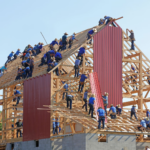Airports are bustling hubs of activity, with thousands of passengers coming and going each day. Behind the scenes, a dedicated team of workers ensures that everything runs smoothly and safely. However, despite stringent safety measures in place, accidents can still occur. One such incident that sends shockwaves through the aviation industry is an airport worker’s fall from a plane.
Understanding the Situation:
What Happened?
The specifics of each incident may vary, but a fall from a plane typically involves an airport worker who comes into contact with an aircraft in some capacity, resulting in them falling from a significant height. This can happen during maintenance work, baggage loading, or any task that requires close proximity to the aircraft.
Causes:
Several factors can contribute to such accidents, including human error, lack of proper safety equipment, poor training, inadequate supervision, or faulty equipment.
Consequences:
A fall from a plane can result in serious injuries or even fatalities. Workers may suffer from broken bones, head injuries, spinal cord damage, or internal injuries depending on the height of the fall and the surface they land on.
Prevention Measures:
Safety Training:
Proper training programs on working at heights and aircraft safety protocols are essential for all airport workers who may come into contact with planes.
Personal Protective Equipment (PPE):
Safety harnesses, helmets, sturdy footwear, and other appropriate PPE should be provided and worn at all times when working in proximity to aircraft.
Regular Safety Inspections:
Regular inspections of equipment, such as ladders, platforms, and safety harnesses, should be conducted to ensure they are in good working condition.
Supervision:
Supervisors should provide adequate oversight to ensure that safety protocols are being followed and intervene if risky behavior is observed.
Reporting Procedures:
Workers should be encouraged to report safety concerns or near-miss incidents to prevent future accidents.
Aftermath and Support:
Medical Attention:
In the event of a fall, immediate medical attention should be sought to assess and treat any injuries sustained.
Counseling and Support:
Workers involved in such accidents may require counseling and support to cope with the trauma and emotional impact of the incident.
Investigation:
An investigation should be conducted to determine the cause of the fall and prevent similar accidents in the future.
FAQ Section:
1. What are the common reasons for airport workers falling from planes?
- Common reasons include lack of proper safety training, equipment malfunction, poor supervision, and complacency.
2. How can airport authorities prevent falls from planes?
- Prevention measures include safety training, proper PPE, regular safety inspections, supervision, and reporting procedures.
3. What should be done if an airport worker falls from a plane?
- Immediate medical attention should be sought, followed by counseling and support for the worker and an investigation into the incident.
4. Are falls from planes common in the aviation industry?
- While such incidents are relatively rare, even a single fall can have devastating consequences, highlighting the need for strict safety measures.
5. How can airport workers cope with the aftermath of a fall from a plane?
- Counseling, support from colleagues and supervisors, and access to medical care are crucial for workers to cope with the physical and emotional impacts of the incident.
In conclusion, a fall from a plane is a harrowing experience that underscores the importance of prioritizing safety in all airport operations. By implementing stringent safety protocols, providing adequate training, and fostering a culture of vigilance and reporting, airport authorities can mitigate the risks associated with working in close proximity to aircraft. Additionally, prompt attention to the aftermath of such incidents is vital to ensure the well-being and recovery of the individuals involved.





